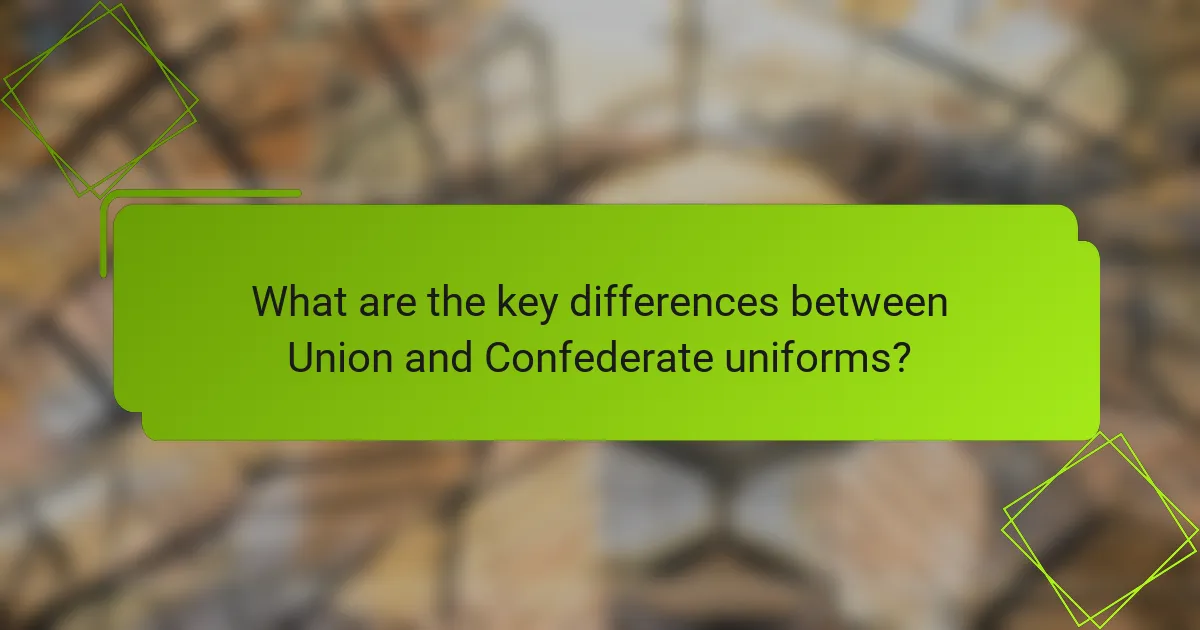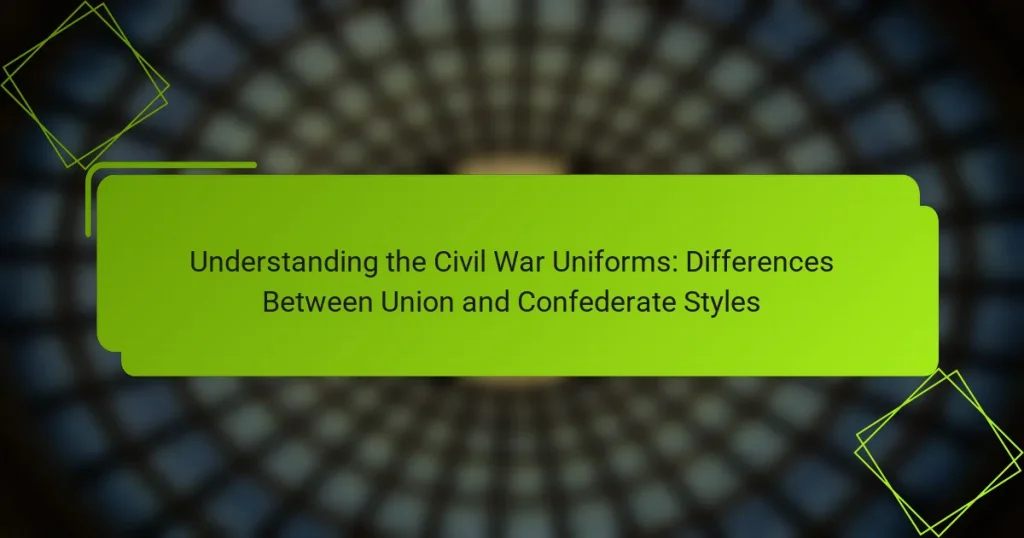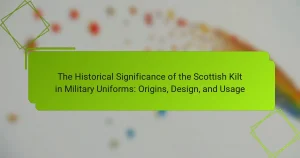The article focuses on the differences between Union and Confederate uniforms during the American Civil War, highlighting key aspects such as color, design, materials, and functionality. Union uniforms were predominantly dark blue, characterized by standardized styles like the sack coat and forage cap, while Confederate uniforms featured a gray color scheme with a variety of local materials leading to inconsistencies. The article discusses how these uniforms served practical purposes for identification and protection, reflecting broader historical contexts and resource availability. Additionally, it examines the impact of fabric quality and design choices on soldiers’ mobility and comfort in battle. Overall, the contrasting uniforms became iconic symbols of the Civil War, representing the distinct identities of the two opposing sides.

What are the key differences between Union and Confederate uniforms?
Union uniforms typically featured a dark blue color, while Confederate uniforms were primarily gray. The Union soldiers wore a variety of styles, including the sack coat and forage cap. Confederate uniforms often included a more varied color palette, sometimes utilizing brown or butternut shades. Union soldiers generally had standardized uniforms, which enhanced uniformity. In contrast, Confederate uniforms were often made from locally sourced materials, leading to inconsistencies. Union insignia were typically displayed prominently, while Confederate insignia varied significantly. The fabric quality in Union uniforms was generally superior due to better supply chains. Confederate uniforms frequently showed signs of wear due to resource shortages.
How did the design of Civil War uniforms reflect the identities of the Union and Confederacy?
The design of Civil War uniforms reflected the distinct identities of the Union and Confederacy. Union uniforms typically featured dark blue wool fabric, symbolizing authority and unity. This color choice was intended to convey a sense of professionalism and order. The use of brass buttons and insignia showcased the military hierarchy and organization within the Union forces.
In contrast, Confederate uniforms were often made from gray or butternut fabric, representing regional pride and a connection to Southern heritage. The gray color was chosen to distinguish the Confederacy from the Union forces. Many Confederate soldiers wore uniforms that were less standardized, reflecting the resource limitations faced by the South. This lack of uniformity highlighted the individualism and localism prevalent in Confederate identity.
Overall, the color schemes and styles of the uniforms served as visual representations of each side’s values and social structures during the Civil War.
What colors were predominantly used in Union and Confederate uniforms?
Union uniforms predominantly used blue. The color blue symbolized the Union’s commitment to preserving the nation. Confederate uniforms primarily featured gray. Gray represented the Southern states’ identity and resistance. The choice of colors became a significant visual distinction between the two factions. Historical records confirm that blue was the official color for Union soldiers, while gray was adopted by Confederate forces. This color differentiation was crucial during battles for identification purposes.
How did the materials used in the uniforms differ between the two sides?
The materials used in the uniforms of the Union and Confederate sides differed significantly. The Union primarily utilized wool and cotton for their uniforms. Wool provided durability and warmth, suitable for various weather conditions. In contrast, the Confederates often relied on a mix of wool and less expensive materials, including cotton and linen. This choice was due to resource shortages in the South. The Union’s access to industrial resources allowed for higher quality fabrics. Meanwhile, Confederate uniforms sometimes featured rougher textures and varied colors due to inconsistent dye availability. This difference in material quality and availability highlighted the economic disparities between the two sides during the Civil War.
What roles did uniforms play in the morale of soldiers during the Civil War?
Uniforms played a significant role in the morale of soldiers during the Civil War. They provided a sense of identity and unity among troops. Soldiers felt pride wearing uniforms that represented their respective sides. The distinct colors and styles helped foster loyalty to their cause. Uniforms also served practical purposes, such as distinguishing friend from foe in battle. This clarity reduced confusion and enhanced battlefield effectiveness. Additionally, uniforms contributed to the psychological aspect of warfare. Soldiers often felt more confident and courageous when dressed in their official attire. Historical accounts show that well-uniformed troops often exhibited higher morale compared to those in civilian clothing.
How did uniforms contribute to the sense of belonging among soldiers?
Uniforms contributed to the sense of belonging among soldiers by creating a visual identity. They distinguished soldiers from different units and factions. This visual identity fostered camaraderie and unity within ranks. Soldiers felt a shared purpose and pride in their attire. The distinct colors and designs represented loyalty to their cause. Uniforms also provided a sense of security and recognition on the battlefield. Historical records indicate that soldiers often formed strong bonds based on their shared uniformity. Such bonds were crucial for morale during the Civil War.
What impact did uniforms have on the perception of the enemy?
Uniforms significantly influenced the perception of the enemy during the Civil War. They created a visual distinction between Union and Confederate forces. This distinction fostered a sense of identity and unity among troops. Soldiers viewed their opponents through the lens of their uniforms. The colors and styles evoked strong emotions and biases. For instance, Union blue was associated with patriotism, while Confederate gray symbolized rebellion. This visual separation often led to dehumanization of the enemy. Historical accounts indicate that soldiers were more likely to see opponents as threats rather than fellow countrymen. Uniforms thus played a critical role in shaping perceptions and attitudes during the conflict.

What are the historical contexts behind Union and Confederate uniforms?
Union and Confederate uniforms were shaped by distinct historical contexts. The Union, representing the Northern states, favored blue uniforms as a symbol of loyalty and unity. This choice was influenced by existing military traditions and the need for a standardized appearance. The Confederacy, representing the Southern states, adopted gray uniforms, reflecting regional pride and resource constraints. The gray color was chosen partly due to its availability in local fabrics.
Uniform designs also differed in function and practicality. Union uniforms were often more uniform in style due to centralized procurement. Confederate uniforms varied widely due to supply shortages and decentralized production. The need for differentiation on the battlefield led to the adoption of distinct colors and styles.
These uniforms became iconic representations of the respective sides during the Civil War. The contrasting colors of blue and gray have since become symbols of the conflict itself. The historical contexts of these uniforms reveal the broader social, economic, and political landscapes of the time.
How did the political climate influence military uniform designs?
The political climate significantly influenced military uniform designs during the Civil War. The Union and Confederate uniforms reflected their respective ideologies and regional identities. Union uniforms emphasized a standardized blue color, symbolizing unity and federal authority. In contrast, Confederate uniforms often featured gray, representing Southern heritage and state rights. The availability of materials also shaped designs. The South faced supply shortages, leading to variations in uniform quality and appearance. Political motivations drove the adoption of specific insignias and decorations to foster morale and loyalty. Historical context reveals that uniforms were not just functional; they were statements of political allegiance and cultural identity.
What were the initial uniform standards set by both the Union and Confederacy?
The initial uniform standards set by the Union included a dark blue wool frock coat, light blue trousers, and a forage cap. The Union’s choice of blue was intended to create a distinct identity. In contrast, the Confederacy adopted a gray uniform, often made from lighter materials due to resource limitations. Confederate soldiers commonly wore a gray wool jacket and trousers. These color choices aimed to symbolize the respective sides in the conflict. The Union’s blue became widely recognized, while gray became synonymous with the Confederacy. Early in the war, variations existed due to supply issues and regional differences. Both sides faced challenges in standardizing uniforms, leading to diverse appearances among troops.
How did supply chain issues affect uniform production during the war?
Supply chain issues significantly hindered uniform production during the war. Limited access to raw materials delayed manufacturing processes. Key supplies like wool and cotton were often in short supply. Transportation disruptions further complicated the logistics of delivering materials to factories. Additionally, the blockade imposed by naval forces restricted imports of necessary textiles. This resulted in inconsistent quality and availability of uniforms. Many soldiers received substandard or incomplete uniforms due to these challenges. Historical records indicate that production fell short of demand, affecting troop readiness. Overall, supply chain problems directly impacted the effectiveness of military uniform distribution.
What were the significant changes in uniform styles throughout the Civil War?
The significant changes in uniform styles throughout the Civil War included variations in color, design, and materials. Early in the war, Union soldiers wore dark blue wool uniforms. These uniforms featured a sack coat design, which was practical for soldiers. The Confederate forces initially adopted gray uniforms, with a mix of fabrics due to supply shortages. As the war progressed, both sides faced issues regarding fabric availability and uniform consistency.
By 1863, the Union introduced the more standardized “Frock Coat” for officers. This coat had a longer cut and was more formal in appearance. The Confederacy began to adopt a more varied palette, including butternut shades, due to resource limitations.
By the war’s end, both sides had seen significant evolution in uniform styles. The Union’s uniforms became more uniform in design, while the Confederacy’s styles became increasingly improvised. Overall, the changes reflected the logistical challenges and evolving military needs of both armies during the Civil War.
How did battles and campaigns influence the evolution of uniform designs?
Battles and campaigns significantly influenced the evolution of uniform designs. The need for practicality and functionality arose during conflicts. Early uniforms were often colorful, but battles revealed the disadvantages of bright colors in combat. Camouflage became essential for concealment. The Civil War saw the introduction of standardized designs for both the Union and Confederate armies. The Union adopted a more practical blue wool uniform, while the Confederates used gray, influenced by their available resources. Historical battles prompted adjustments in fabric and cut to improve soldier mobility and comfort. Over time, uniforms evolved to incorporate features like pockets and insignia for identification. The continuous feedback from battlefield experiences shaped uniform designs throughout military history.
What innovations emerged in military uniforms during this period?
Innovations in military uniforms during the Civil War included the introduction of standardized designs and materials. The Union adopted a more uniform look with the use of wool fabric, which provided durability and warmth. The introduction of the forage cap, or “kepi,” became popular among Union soldiers for practicality. Confederate uniforms often featured a mix of gray shades, with some troops using homespun fabrics due to supply shortages. Additionally, the use of insignia to denote rank and unit became more prevalent, enhancing organization within the ranks. These changes reflected the need for functionality and identification in the field.

How can we analyze the practical aspects of Civil War uniforms?
Analyzing the practical aspects of Civil War uniforms involves examining their design, materials, and functionality. Civil War uniforms were designed for both identification and protection. The Union and Confederate uniforms had distinct colors and styles, aiding in troop recognition. Materials used included wool and cotton, impacting durability and comfort. The cut and fit of the uniforms affected soldiers’ mobility in battle. Historical records indicate that uniforms were often tailored to local climates, influencing their practicality. For instance, lighter fabrics were used in warmer regions. Additionally, the presence of pockets and insignia served practical purposes for carrying supplies and rank identification. Overall, these factors highlight how Civil War uniforms were crafted to meet the demands of warfare while also reflecting the identity of the respective armies.
What were the functional features of Union and Confederate uniforms?
Union and Confederate uniforms had distinct functional features tailored for their respective armies. Union uniforms typically included a dark blue wool fabric, which provided durability and warmth. They often featured a forage cap and a frock coat for ease of movement. The blue color also aided in identification during battle. Confederate uniforms, on the other hand, were primarily made of gray wool, which was less expensive and more readily available. They often had a simpler design with fewer embellishments, focusing on practicality. Both uniforms included brass buttons and insignia to denote rank. The functional features of these uniforms were essential for maintaining order and discipline in the field.
How did the design of uniforms accommodate the needs of soldiers in battle?
The design of uniforms accommodated the needs of soldiers in battle by prioritizing functionality and protection. Uniforms were made from durable materials to withstand harsh conditions. They featured practical elements like pockets for carrying essential items. The color of the uniforms helped with identification in the field. For example, Union soldiers wore blue while Confederate soldiers wore gray. This color distinction reduced friendly fire incidents. Additionally, uniforms included features that allowed for ease of movement during combat. Overall, the design focused on enhancing soldier performance and safety in battle scenarios.
What were the common accessories and insignia found on these uniforms?
Common accessories and insignia found on Civil War uniforms included buttons, epaulettes, and sashes. Union soldiers typically wore brass buttons with the eagle insignia. Confederate uniforms often featured buttons with the Confederate flag or other symbols. Epaulettes indicated rank and were commonly used by both sides. Sashes were worn around the waist, particularly by officers, to signify rank and branch of service. Other accessories included belts with distinctive buckles and cartridge boxes. These elements were essential for identification and functionality in the field.
What lessons can modern military uniforms learn from Civil War styles?
Modern military uniforms can learn several lessons from Civil War styles. These lessons include the importance of functionality, distinctiveness, and historical significance. Civil War uniforms prioritized practicality for soldiers in combat. They featured durable materials and designs that accommodated movement. Modern uniforms can benefit from similar focus on utility.
Additionally, the distinct colors and insignia of Civil War uniforms helped identify units quickly. This aspect of visibility is crucial for contemporary military operations. The historical significance of these styles can also enhance the sense of pride and identity among service members.
By integrating these lessons, modern military uniforms can improve both performance and morale.
How do historical uniform designs influence contemporary military attire?
Historical uniform designs significantly influence contemporary military attire. Many modern military uniforms incorporate elements from past designs for functionality and symbolism. Features such as color, fabric, and cut often reflect historical styles. For example, the use of wool in uniforms traces back to the 19th century. The iconic blue and gray colors from the Civil War still appear in modern U.S. military uniforms. Additionally, insignia and rank markings are derived from historical practices. These elements serve to foster a sense of tradition and continuity. Overall, contemporary military attire is a blend of historical influences and modern requirements.
What best practices can be derived from the study of Civil War uniforms?
Best practices derived from the study of Civil War uniforms include understanding the significance of color and design. The Union and Confederate uniforms had distinct colors that represented their respective sides. For example, Union soldiers typically wore blue, while Confederate soldiers wore gray. Recognizing these color codes helps in historical accuracy for reenactments and education.
Another best practice is the analysis of materials used in the uniforms. Wool was commonly used for its durability and warmth. This knowledge can inform modern fabric choices for historical reproductions. Additionally, understanding the varying styles of insignia can aid in identifying ranks and roles within the military structure.
Finally, studying the evolution of uniform designs throughout the war reveals practical adaptations made in response to battlefield conditions. This insight can guide contemporary military uniform development by emphasizing functionality and adaptability.
The main entity of the article is Civil War uniforms, specifically the differences between Union and Confederate styles. The article examines the distinct characteristics of these uniforms, including color, material, design, and insignia, highlighting how they reflected the identities and values of each side during the conflict. Key topics include the impact of supply chain issues on uniform production, the role uniforms played in soldier morale and identity, and the evolution of styles throughout the war. Additionally, the article discusses the historical contexts influencing uniform designs and the lessons that modern military attire can learn from these historical examples.




